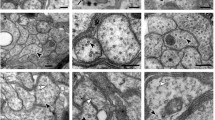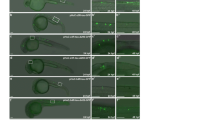Abstract
Small-molecule inhibitors of neurofibrillary lesion formation may have utility for treatment of Alzheimer’s disease and certain forms of frontotemporal lobar degeneration. These lesions are composed largely of tau protein, which aggregates to form intracellular fibrils in affected neurons. Previously it was shown that chronic overexpression of human tau protein within identified neurons (anterior bulbar cells) of the sea lamprey induced a phenotype-resembling tauopathic neurodegeneration, including the formation of tau filaments, fragmentation of dendritic arbors, and eventual cell death. Development of this neurodegenerative phenotype was blocked by chronic administration of a benzothiazole derivative termed N3 ((E)-2-[[4-(dimethylamino)phenyl]azo]-6-methoxybenzothiazole) to lamprey aquaria. Here we examined the mechanism of action of N3 and an alkene analog termed N4 ((E)-2-[2-[4-(dimethylamino)phenyl]ethenyl]-6-methoxybenzothiazole) in vitro and in the lamprey model. Results showed that although both compounds entered the lamprey central nervous system, only N3 arrested tauopathy. On the basis of in vitro aggregation assays, neither compound was capable of directly inhibiting tau filament formation. However, N3, but not N4, was capable of partially antagonizing the binding of Thioflavin S to synthetic tau filaments. The results suggest that occupancy of N3-binding sites on nascent tau filaments may significantly retard the progressive degeneration accompanying tau overexpression in lamprey.






Similar content being viewed by others
References
Braak H, Braak E (1995) Staging of Alzheimer’s disease-related neurofibrillary changes. Neurobiol Aging 16:271–278
Brown MR, Bondada V, Keller JN, Thorpe J, Geddes JW (2005) Proteasome or calpain inhibition does not alter cellular tau levels in neuroblastoma cells or primary neurons. J Alzheimers Dis 7:15–24
Buee L, Bussiere T, Buee-Scherrer V, Delacourte A, Hof PR (2000) Tau protein isoforms, phosphorylation and role in neurodegenerative disorders. Brain Res Brain Res Rev 33:95–130
Caprathe BW, Gilmore JL, Hays SJ, Jaen JC, LeVine H (1999) Method of imaging amyloid deposits. US Patent 6,001,331
Carmel G, Mager EM, Binder LI, Kuret J (1996) The structural basis of monoclonal antibody Alz50’s selectivity for Alzheimer’s disease pathology. J Biol Chem 271:32789–32795
Chirita CN, Necula M, Kuret J (2003) Anionic micelles and vesicles induce tau fibrillization in vitro. J Biol Chem 278:25644–25650
Delobel P, Leroy O, Hamdane M, Sambo AV, Delacourte A, Buee L (2005) Proteasome inhibition and Tau proteolysis: an unexpected regulation. FEBS Lett 579:1–5
Feuillette S, Blard O, Lecourtois M, Frebourg T, Campion D, Dumanchin C (2005) Tau is not normally degraded by the proteasome. J Neurosci Res 80:400–405
Friedhoff P, Schneider A, Mandelkow EM, Mandelkow E (1998) Rapid assembly of Alzheimer-like paired helical filaments from microtubule-associated protein tau monitored by fluorescence in solution. Biochemistry 37:10223–10230
Gamblin TC, King ME, Kuret J, Berry RW, Binder LI (2000) Oxidative regulation of fatty acid-induced tau polymerization. Biochemistry 39:14203–14210
Ghoshal N, Smiley JF, DeMaggio AJ, Hoekstra MF, Cochran EJ, Binder LI, Kuret J (1999) A new molecular link between the fibrillar and granulovacuolar lesions of Alzheimer’s disease. Am J Pathol 155:1163–1172
Ghoshal N, Garcia-Sierra F, Wuu J, Leurgans S, Bennett DA, Berry RW, Binder LI (2002) Tau conformational changes correspond to impairments of episodic memory in mild cognitive impairment and Alzheimer’s disease. Exp Neurol 177:475–493
Goedert M, Spillantini MG, Cairns NJ, Crowther RA (1992) Tau proteins of Alzheimer paired helical filaments: abnormal phosphorylation of all six brain isoforms. Neuron 8:159–168
Goldbaum O, Richter-Landsberg C (2004) Proteolytic stress causes heat shock protein induction, tau ubiquitination, and the recruitment of ubiquitin to tau-positive aggregates in oligodendrocytes in culture. J Neurosci 24:5748–5757
Goldstein A (1944) Mechanism of enzyme-inhibitor-substrate reactions. Cholinesterase-eserine-acetylcholine system. J Gen Physiol 27:529–580
Gotz J, Deters N, Doldissen A, Bokhari L, Ke Y, Wiesner A, Schonrock N, Ittner LM (2007) A decade of tau transgenic animal models and beyond. Brain Pathol 17:91–103
Gray EG, Paula-Barbosa M, Roher A (1987) Alzheimer’s disease: paired helical filaments and cytomembranes. Neuropathol Appl Neurobiol 13:91–110
Hall GF, Poulos A, Cohen MJ (1989) Sprouts emerging from the dendrites of axotomized lamprey central neurons have axonlike ultrastructure. J Neurosci 9:588–599
Hall GF, Yao J, Selzer ME, Kosik KS (1997) Cytoskeletal changes correlated with the loss of neuronal polarity in axotomized lamprey central neurons. J Neurocytol 26:733–753
Hall GF, Chu B, Lee G, Yao J (2000) Human tau filaments induce microtubule and synapse loss in an in vivo model of neurofibrillary degenerative disease. J Cell Sci 113:1373–1387
Hall GF, Lee VM, Lee G, Yao J (2001) Staging of neurofibrillary degeneration caused by human tau overexpression in a unique cellular model of human tauopathy. Am J Pathol 158:235–246
Hall GF, Lee S, Yao J (2002) Neurofibrillary degeneration can be arrested in an in vivo cellular model of human tauopathy by application of a compound which inhibits tau filament formation in vitro. J Mol Neurosci 19:253–260
Heiser V, Engemann S, Brocker W, Dunkel I, Boeddrich A, Waelter S, Nordhoff E, Lurz R, Schugardt N, Rautenberg S, Herhaus C, Barnickel G, Bottcher H, Lehrach H, Wanker EE (2002) Identification of benzothiazoles as potential polyglutamine aggregation inhibitors of Huntington’s disease by using an automated filter retardation assay. Proc Natl Acad Sci USA 99:16400–16406
Honson NS, Kuret J (2008) Tau aggregation and toxicity in tauopathic neurodegenerative diseases. J Alzheimers Dis 14:417–422
Honson NS, Johnson RL, Huang W, Inglese J, Austin CP, Kuret J (2007) Differentiating Alzheimer disease-associated aggregates with small molecules. Neurobiol Dis 363:229–234
Ihara Y (1988) Massive somatodendritic sprouting of cortical neurons in Alzheimer’s disease. Brain Res 459:138–144
Inbar P, Yang J (2006) Inhibiting protein–amyloid interactions with small molecules: a surface chemistry approach. Bioorg Med Chem Lett 16:1076–1079
Inbar P, Li CQ, Takayama SA, Bautista MR, Yang J (2006) Oligo(ethylene glycol) derivatives of thioflavin T as inhibitors of protein–amyloid interactions. ChemBioChem 7:1563–1566
Keck S, Nitsch R, Grune T, Ullrich O (2003) Proteasome inhibition by paired helical filament-tau in brains of patients with Alzheimer’s disease. J Neurochem 85:115–122
King ME, Gamblin TC, Kuret J, Binder LI (2000) Differential assembly of human tau isoforms in the presence of arachidonic acid. J Neurochem 74:1749–1757
Kowall NW, Kosik KS (1987) Axonal disruption and aberrant localization of tau protein characterize the neuropil pathology of Alzheimer’s disease. Ann Neurol 22:639–643
Krebs MR, Bromley EH, Donald AM (2005) The binding of thioflavin-T to amyloid fibrils: localisation and implications. J Struct Biol 149:30–37
Kuret J (2007) Detection and Reduction of Neurofibrillary Lesions. In: Smith HJ, Sewell RDE, Simons C (eds) Protein folding diseases: enzyme inhibitors, other agents as prospective therapies. CRC Press Taylor & Francis Books, Boca Raton, FL, pp 287–324
Kuret J, Khatami K (2002) Methods for inhibiting or reversing tau filament formation. US Patent 6,479,528
Kuret J, Johnson GS, Cha D, Christenson ER, DeMaggio AJ, Hoekstra MF (1997) Casein kinase 1 is tightly associated with paired-helical filaments isolated from Alzheimer’s disease brain. J Neurochem 69:2506–2515
Lee VM, Goedert M, Trojanowski JQ (2001) Neurodegenerative tauopathies. Annu Rev Neurosci 24:1121–1159
Lockhart A, Ye L, Judd DB, Merritt AT, Lowe PN, Morgenstern JL, Hong G, Gee AD, Brown J (2005) Evidence for the presence of three distinct binding sites for the thioflavin T class of Alzheimer’s disease PET imaging agents on β-amyloid peptide fibrils. J Biol Chem 280:7677–7684
McKee AC, Kowall NW, Kosik KS (1989) Microtubular reorganization and dendritic growth response in Alzheimer’s disease. Ann Neurol 26:652–659
Necula M, Kuret J (2004) Electron microscopy as a quantitative method for investigating tau fibrillization. Anal Biochem 329:238–246
Sahara N, Maeda S, Murayama M, Suzuki T, Dohmae N, Yen SH, Takashima A (2007) Assembly of two distinct dimers and higher-order oligomers from full-length tau. Eur J NeuroSci 25:3020–3029
Sanfilippo PJ, Urbanski M, Press JB, Dubinsky B, Moore JB Jr (1988) Synthesis of (aryloxy)alkylamines. 2. Novel imidazo-fused heterocycles with calcium channel blocking and local anesthetic activity. J Med Chem 31:2221–2227
Segel IH (ed) (1975) Enzyme kinetics: behavior and analysis of rapid equilibrium and steady-state enzyme systems. Wiley, New York
Torack RM, Alcala H, Gado M, Burton R (1976) Correlative assay of computerized cranial tomography CCT, water content and specific gravity in normal and pathological postmortem brain. J Neuropathol Exp Neurol 35:385–392
Voneche V, Portetelle D, Kettmann R, Willems L, Limbach K, Paoletti E, Ruysschaert JM, Burny A, Brasseur R (1992) Fusogenic segments of bovine leukemia virus and simian immunodeficiency virus are interchangeable and mediate fusion by means of oblique insertion in the lipid bilayer of their target cells. Proc Natl Acad Sci USA 89:3810–3814
Yamaguchi H, Nakazato Y, Shoji M, Ihara Y, Hirai S (1990) Ultrastructure of the neuropil threads in the Alzheimer brain: their dendritic origin and accumulation in the senile plaques. Acta Neuropathol (Berl) 80:368–374
Ye L, Morgenstern JL, Lamb JR, Lockhart A (2006) Characterisation of the binding of amyloid imaging tracers to rodent Aβ fibrils and rodent-human Aβ co-polymers. Biochem Biophys Res Commun 347:669–677
Zhang X, Smith DL, Meriin AB, Engemann S, Russel DE, Roark M, Washington SL, Maxwell MM, Marsh JL, Thompson LM, Wanker EE, Young AB, Housman DE, Bates GP, Sherman MY, Kazantsev AG (2005) A potent small molecule inhibits polyglutamine aggregation in Huntington’s disease neurons and suppresses neurodegeneration in vivo. Proc Natl Acad Sci USA 102:892–897
Acknowledgments
We thank Xian Yu for assistance with ThS fluorescence assays, Carmen Chirita and Mihaela Necula for electron microscopy images, and Jun Yao for immunohistochemical processing of lamprey samples. This research was supported by grants from the National Institutes of Health (AG14452 and MH077621; J.K.; AG018661; A.A.), and the Alzheimer’s Association (IIRG-05-14288; J.K.).
Author information
Authors and Affiliations
Corresponding author
Rights and permissions
About this article
Cite this article
Honson, N.S., Jensen, J.R., Abraha, A. et al. Small-Molecule Mediated Neuroprotection in an In Situ Model of Tauopathy. Neurotox Res 15, 274–283 (2009). https://doi.org/10.1007/s12640-009-9028-y
Received:
Revised:
Accepted:
Published:
Issue Date:
DOI: https://doi.org/10.1007/s12640-009-9028-y




